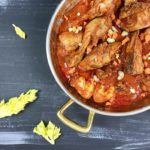BEEF BRAISED IN BAROLO WINE, REAL ITALIAN LUXURY

A luxurious braised beef in a precious wine like Barolo, again a recipe from Piedmont.A real comfort food,above all if served with polenta and its sauce or with borretane onions.
Beef braised in Barolo is typical of festivities and holidays. This special dish contemplates the cost of the ingredients and the time – both the marinading and cooking time – involved in its preparation.
The secret of its success rests in the quality of the ingredients and the cooking method: after marinading, it is necessary to pat the meat dry and brown it in olive oil to “seal” the meat and avoid its loss of juices.
Prep Time: 30 minutes | Cooking Time: 2 hours | Total Time: 14 hours + 30 minutes (including 12 hours marinating | Yield: Makes 6 servings.
Ingredients
- 4-pound (1,2 kg) boneless beef roast – chuck or sirloin trimmed of excess fat. These cuts do well for braising – 1,2 kg
- 1 1/2 teaspoons coarse sea salt
- 1/2 cup (5 spoons) extra virgin olive oil
- 2 medium onions, peeled and diced
- 4 medium carrots, peeled and diced
- 3 large celery stalks, diced (the vegetables should be chopped in similar sized pieces to ensure even cooking)
- 2 plump garlic cloves, peeled with internal germ removed
- 1 sprig fresh rosemary with lots of needles
- 5 – 6 whole peppercorns
- 1 750 millilitre bottle of Barolo wine (if substituting wine for another select a good drinkable red wine and extend the marinating time by 6 hours)
- Freshly ground black pepper to taste
- 1 – 2 bay leaves
- 1 tablespoon + 1/2 teaspoon (50 gr.) butter
- 3 – 4 whole cloves
Recommended equipment
A heavy saucepan, enamelled cast-iron dutch-oven, glass or ceramic round or oval pan with a cover. Select a pot in which the roast will fit with no more than 2 inches of space around it. (The less space in the pot the less wine you’ll need). Select a bowl in glass or ceramic of similar size.
Instructions
Start marinating the meat in the wine and herbs the night before to ensure it marinates a minimum of 12 hours.
Dry the meat with paper towels and place in the bowl. Add half of the diced vegetables, garlic cloves, the rosemary, peppercorns, and the bay leaves. Put the remaining vegetables in a covered container and place in the fridge for later when they will be added when cooking the meat. Pour the bottle of wine over the meat and vegetables ensuring everything is completely submerged. Season with salt and pepper. Cover the bowl with plastic wrap and place in the fridge (in the warmest section) for at least 12 hours.
When ready to cook, remove the meat from the marinade, dry using paper towels and put the roast into a pan that you have previously added the oil and butter and warmed slightly. Brown it on all side for 4 – 5 minutes. Using a slotted spoon remove the vegetables and aromatic herbs from the marinade and add them to the roast. At this time, add the reserved vegetables from the fridge. Cook this mixture for 10 – 15 minutes, stirring frequently just until the vegetables soften. Once the vegetables have softened add all the marinade, bring to a boil, then reduce heat, cover, and let simmer for approximately two hours. Rotate the roast so it is submerged in the braising liquid. Braise this way, turning the meat every 30 minutes, never using a fork that would pierce the meat and cause it to lose its juices.
Once the meat has finished cooking, remove the meat to a platter and cover with tinfoil to keep warm. Take the saucepan off the burner, remove the rosemary and bay leaves.
Make a puree with the vegetables and marinade together with an immersion blender. Heat to a boil, reducing the sauce to a consistency that coats the back of a spoon. Season the sauce to taste with salt and freshly ground pepper.
To serve – slice the meat crosswise (against the grain). Heat the sauce to a gentle simmer, then spoon over the beef so the slices are lightly coated.
In Italy it is usually served with mashed potatoes or sweet and sour borettane onions.


